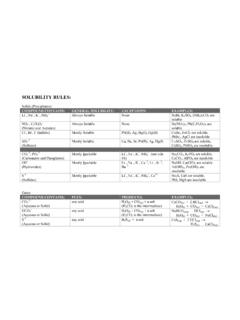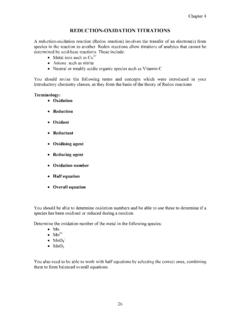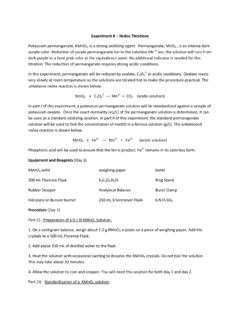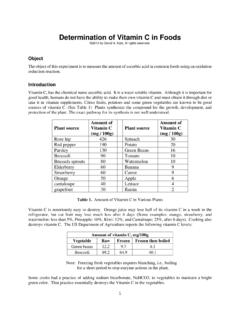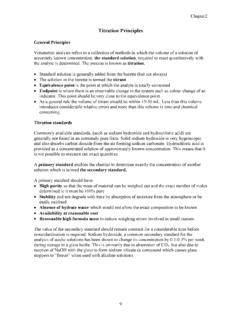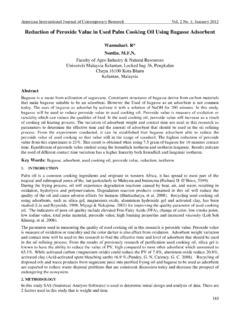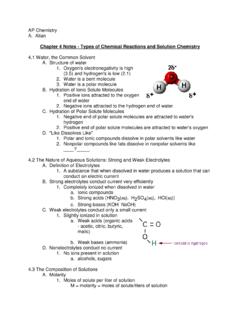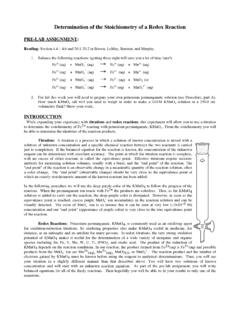Transcription of TITRATION OF VITAMIN C - Heartland Community College
1 TITRATION OF VITAMIN C. Introduction: In this lab, we will be performing two different types of titrations on ascorbic acid, more commonly known as VITAMIN C. The first will be an acid-base TITRATION in which we will use a base (NaOH) with a known concentration to react with the ascorbic acid. The second will be an oxidation-reduction TITRATION in which we will use an oxidizing agent (NaIO3) to oxidize the ascorbic acid. Background: An acid-base TITRATION is a very common tool used to determine the concentration of an unknown acid. For our example, a TITRATION of sodium hydroxide with ascorbic acid will be performed. The balanced reaction is: (1) HC6H7O6 + NaOH NaC6H7O6 + H2O. For our endpoint, we will use a standard indicator, phenolphthalein, which will change our colorless solution to a pink color. An oxidation-reduction reaction can also be used in many titrations . For our example, sodium iodate, an oxidizing agent, will oxidize the ascorbic acid.
2 The balanced reaction is: (2) 3 HC6H7O6 + NaIO3 3 C6H6O6 + NaI + 3 H2O. The indicator in this reaction is starch, which produces a dark blue color in the presence of I- at the endpoint. In our experiment, the TITRATION will be first performed on pure ascorbic acid to test our TITRATION skills. Thus, our percent purity of the ascorbic acid should be about 100% for both trials. Note that the two types of titrations will be performed on the same sample of ascorbic acid before continuing to the next trial. Therefore, it is important to set up both parts of the TITRATION at the same time. In the second part of the experiment, an actual VITAMIN C. tablet will be ground up and tested to determine its mass of ascorbic acid present. Calculations: The calculations are all based on the stoichiometry from the above reactions. Remember that the Molarity times the Volume (in liters) always equals the number of moles reacted in a TITRATION . Ex) of a solution is dispensed from the burette.
3 How many moles were added? ( mol/L) x = moles Also, keep in mind the mole ratios in the balanced reactions. For the first reaction, one mole of ascorbic acid is consumed for every one mole of NaOH added. For the second reaction, three moles of ascorbic acid are consumed for every one mole of NaIO3 added. Lastly, you will need to determine the molecular weight of the ascorbic acid whose formula is HC6H7O6. Procedure: Pure Ascorbic Acid 1. Set up a ring stand with one clamp and two burettes secured to it. 2. Weigh out about grams of ascorbic acid using a spatula and weighing paper. Record the actual mass used. 3. Add the ascorbic acid to a 125mL Erlenmeyer flask, add about 50mL of distilled water, and stir until the solid dissolves. 4. Add two drops of phenolphthalein to the flask. 5. Obtain about of 1M HCl in a 100-mL beaker. When not in use, cover with a watch glass. 6. In a 10-mL graduated cylinder, measure out of 1M HCl. Put aside for later use.
4 7. In separate beakers, obtain about 75mL of each of the stock solutions NaOH. and NaIO3 to use as your supply for the burettes. Fill one of the burettes with NaOH and the other with NaIO3 using a clean funnel. 8. Begin adding the NaOH about 1mL at a time. Remember to constantly stir the solution to keep it mixed. 9. Eventually the solution will begin to turn a pinkish color that persists longer and longer. This means that the endpoint is near and you should add the NaOH more slowly. The endpoint will be signified by the complete color change that persists for at least 30. seconds with stirring. Record the volume of NaOH that was added. 10. DO NOT DISCARD OR WORK ON THE CALCULATIONS. Re-acidify the contents of the flask by adding the of 1M HCl set aside in step #6. 11. Then, add about 3-4 drops of the starch solution. 12. Begin adding the NaIO3 about 1mL at a time. This endpoint will be signified by a dark bluish (or sometimes brown) color change that persists with stirring.
5 Record the volume of NaIO3 used. 13. You will now repeat the above procedure again using a similar mass of ascorbic acid. Since you know the approximate endpoints of each TITRATION , you can proceed to titrate rapidly to about 2mL short of the endpoint and then add the solution slowly. Your results on the second TITRATION should be better than the first one. Record your results. VITAMIN C Tablet 1. Choose one of the two tablets and weigh it. With a mortar and pestle, grind it up. 2. Add the tablet to the Erlenmeyer flask and with some distilled water wash any remaining solids into the flask. 3. Add water until the total volume is about 75mL's. Stir the solution for a few minutes. Note not all of the tablet will dissolve because they contain some insoluble starches. 4. Add a few drops of the phenolphthalein indicator solution. 5. Begin titrating with the NaOH again. The endpoint can come at any time, so proceed slowly. 6. After the endpoint is reached, record the volume of NaOH used.
6 7. Re-acidify with of 1M HCl again and add 3 4 drops of the starch solution. 8. Begin titrating with the NaIO3. Record the volume used. 9. Repeat steps 1 8 with the other tablet. Data: Pure Ascorbic Acid Trial #1 Trial #2. 1. mass of ascorbic acid 2. volume of NaOH added 3. moles of NaOH. 4. moles of ascorbic acid consumed 5. grams of ascorbic acid (not same as #1). 6. percent purity (line 5/line 1 x 100%). 7. volume of NaIO3 added 8. moles of NaIO3. 9. moles of ascorbic acid consumed 10. mass of ascorbic acid 11. percent purity (line 10/line 1 x 100%). Calculations VITAMIN C tablet Tablet Tablet #1 #2. 1. mass of Tablet 2. volume of NaOH added 3. moles of NaOH. 4. moles of ascorbic acid consumed 5. mass of ascorbic acid 6. percent purity (line 5/line 1 x 100%). 7. volume of NaIO3 added 8. moles of NaIO3. 9. moles of ascorbic acid consumed 10. mass of ascorbic acid 11. percent purity (line 10/line 1 x 100%). 12. average mass (lines 5 and 10). Questions: 1.
7 How many milligrams of VITAMIN C are advertised on the label? Tablet 1: Tablet 2: 2. Determine the percent error for each of the two tablets. Tablet 1: Tablet 2: Prelab: 1. What is the MW of ascorbic acid? 2. If a TITRATION used of a NaOH solution to reach the endpoint, then how many moles of NaOH were consumed? 3. How many moles of ascorbic acid reacted from Q#2? 4. If a TITRATION used of a NaIO3 solution to reach the endpoint, then how many moles of NaIO3 were consumed? 5. How many moles of ascorbic acid reacted?

